#Cow Dung Organic Fertilizer
Explore tagged Tumblr posts
Text
Understanding NPK Analysis in Different Types of Manure: A Guide for Farmers
Manure is one of the most cost-effective and environmentally friendly fertilizers available to farmers. However, not all manure is created equal. Understanding the nutrient composition—commonly expressed as NPK (Nitrogen, Phosphorus, Potassium)—is crucial for optimizing crop yields and soil health. Here’s a detailed breakdown of the NPK analysis for common types of manure, along with…
#chicken manure benefits#composting manure#cow dung farming#crop-specific fertilizers.#farmers trend#farming best practices.#goat manure fertilizer#manure NPK analysis#manure types comparison#nitrogen-rich manure#organic farming techniques#organic fertilizers#phosphorus in manure#pig manure composting#potassium in manure#rabbit manure nutrients#sheep manure uses#soil fertility tips#sustainable farming#vegetable farming fertilizer
0 notes
Text
Advantages of using Desi Cow Dung Cake
Organic Fertilizer: Desi Cow Dung Cake is an excellent organic fertilizer, enriching the soil with essential nutrients like nitrogen, phosphorus, and potassium.
Soil Health: Regular application of Desi Cow Dung Cake improves soil structure, enhances moisture retention, and promotes the growth of beneficial microorganisms, thus boosting overall soil health.
Natural Pest Repellent: Cow dung contains natural insect-repelling properties, helping to deter pests and insects from infesting plants and crops.
Eco-Friendly: Desi Cow Dung Cake is a sustainable and eco-friendly alternative to chemical fertilizers, as it is biodegradable and does not harm the environment.
Enhanced Crop Yield: The nutrient-rich composition of Desi Cow Dung Cake supports healthy plant growth and development, leading to increased crop yield and quality.
Balanced pH Levels: Cow dung helps to maintain balanced pH levels in the soil, creating optimal conditions for plant growth and nutrient absorption.
Improves Soil Fertility: Desi Cow Dung Cake replenishes soil fertility by supplying essential nutrients and organic matter, thereby revitalizing depleted soils.
Cost-Effective: Using Desi Cow Dung Cake as fertilizer is cost-effective compared to synthetic fertilizers, as it is readily available and often sourced from local farms.
Versatile Usage: Apart from fertilizing soil, Desi Cow Dung Cake can be used for various purposes such as fuel, insulation, and traditional rituals, showcasing its versatility.
Cultural Significance: In many cultures, cow dung holds cultural and religious significance, symbolizing purity, prosperity, and fertility. Utilizing Desi Cow Dung Cake honors these traditions and rituals.
For Orders Call/Whats up: +91 9886112035
0 notes
Text
Cow dung organic fertilizer production line process
Cow dung organic fertilizer production line is a complete set of equipment for processing organic fertilizer with cow dung as raw material. The whole set of equipment requires fermentation turning machine, semi-wet material pulverizer, drum screening machine, horizontal mixer, disc granulator, dryer, cooling machine, drum screening machine, coating machine, automatic quantitative packaging machine and other equipment.
Cow dung organic fertilizer production line process:
1. Add organic solid solid waste (such as straw, sawdust, rice bran, bean cake, etc.) with a moisture content of less than 60% in fresh cow dung as auxiliary materials and mix them with microbial fermentation agents to regulate moisture and ventilation Compared with carbon and nitrogen.
2. Use the batching bin to mix composted materials, N, P, K and other inorganic fertilizers and other additives according to a certain proportion through the pulverizer and mixer for proportioning, crushing and mixing.
3. The organic fertilizer drum granulator is used to granulate the material. Through a certain amount of water or steam, the cow dung organic fertilizer is fully chemically reacted after the humidity is adjusted in the cylinder. Under certain liquid phase conditions, with the help of the rotating motion of the cylinder, the extrusion force between the material particles is agglomerated into balls.
4. Use an organic fertilizer dryer to further remove moisture from the sieved particles to meet the standard requirements for the moisture content of organic fertilizers.
5. Use a cooling machine to cool the granular materials.
6. The cooled granular material is conveyed into the drum screening machine for screening.
7. Qualified granular organic fertilizers are packaged with automatic packaging machines.
Zhengzhou Jiutian specializes in the production of various organic fertilizer production equipment. If you are interested in, please contact us.
0 notes
Text
Organic Manure Powder | Organic fertilizer 1 Pack 50 kg
Organic manure powder is a type of organic fertilizer that is made from organic materials. It contains a variety of nutrients that are essential for plant growth, including nitrogen, phosphorus, potash, calcium, magnesium, zinc, boron, copper, humic acid, amino acids and seaweeds. The process of preparing organic manure involves mixing different organic materials such as cow dung, poultry manure, rock phosphate, bio-compost, and gypsum.
https://www.narmadagro.com/organic-manure-powder/
0 notes
Text

Embracing a Holistic Approach: The Multifaceted Activities of Shree Krishnayan Gaurakshashala
In the heart of India, Shree Krishnayan Gaurakshashala stands as a beacon of compassion and sustainability, embodying a deep commitment to the well-being of cows, community, and the environment. Through a series of dedicated initiatives, the gaushala has transformed into a multifaceted hub where spiritual, agricultural, and humanitarian efforts converge to create a positive impact on society. Here’s a closer look at the diverse activities undertaken by this remarkable institution.
Cow Protection: A Sanctuary of Hope
Home to over 21,000 stray and destitute Desi Indian cows and bulls, Shree Krishnayan Gaurakshashala provides a sanctuary where these revered creatures receive a second chance at life. Rescued through various channels, including police, government agencies, NGOs, and farmers, these gauvansh are sheltered, nourished, and cared for with utmost dedication. The gaushala’s in-house medical facility, staffed by experienced veterinarians, ensures that each cow receives timely and comprehensive healthcare, fostering their well-being and longevity.
Shelter and Nourishment: Building a Safe Haven
The gaushala boasts expansive shelters, meticulously designed to accommodate the growing number of protected cows. These shelters provide a comfortable and dignified living environment, reflecting the institution’s commitment to creating a holy and safe space for gauvansh. Nourishment is another cornerstone of care at the gaushala, where a balanced diet of dry fodder, green fodder, grains, mustard cake, and jaggery is carefully prepared and served twice daily. This holistic approach to feeding ensures that the cows remain healthy, strong, and vibrant.
Medical Care: Ensuring Health and Well-Being
Around-the-clock medical care is a priority at Shree Krishnayan Gaurakshashala. With a fully equipped medical facility on-site, the gaushala is prepared to handle any health concerns that may arise. From routine check-ups to emergency care, the dedicated team of veterinarians and support staff work tirelessly to maintain the health and well-being of the gauvansh. Ample stocks of medicines and vaccinations are maintained to prevent and treat illnesses, ensuring that each cow receives the best possible care.
Breeding and Training: Promoting Indigenous Cows
The gaushala is actively involved in research and breeding programs aimed at enhancing the genetic traits of indigenous cows. By focusing on disease resistance, adaptability, and milk production, the institution seeks to create a sustainable ecosystem where farmers are encouraged to keep Desi cows. Additionally, vocational training programs are offered to farmers, educating them on the importance of organic farming and the benefits of desi cows and bulls. These initiatives aim to preserve cultural heritage and promote sustainable agricultural practices.
Renewable Energy and Organic Farming: Pioneering Sustainability
Shree Krishnayan Gaurakshashala is a model of sustainability, harnessing renewable energy through biogas plants and solar power systems. The gaushala’s BIO CNG plant, powered by ONGC, converts 25,000 kg of cow dung daily into CNG gas and manure, contributing to a cleaner environment and the production of organic fertilizers. The institution also promotes organic farming, encouraging pesticide-free crops and eco-friendly practices, with a mission to convert surrounding villages into organic lands.
Humanitarian Efforts: Serving Communities in Need
Beyond its work with cows, Shree Krishnayan Gaurakshashala extends its compassion to human communities, especially during times of calamity. From providing relief during floods in Madhya Pradesh and Uttarakhand to distributing food during the COVID-19 pandemic, the gaushala’s humanitarian efforts have touched countless lives. The institution regularly sends truckloads of supplies to remote regions and runs food camps, ensuring that those in need receive essential nourishment and support.
Spiritual and Cultural Initiatives: Nurturing the Soul
The gaushala is also a center for spiritual and cultural enrichment. The magnificent yagya mandap, situated on the serene banks of the Ganga, hosts various sacred rituals, including Yagyas, Pujas, and Japas. These spiritual endeavors are conducted by accomplished Vedic Brahmins, creating an atmosphere of divine grace and positive energy. The institution’s yoga center, in collaboration with Jhanvi Yoga Dhyan Sevashram Trust, offers yoga, meditation, and Ayurvedic treatments, promoting holistic well-being and spiritual growth.
Conclusion
Shree Krishnayan Gaurakshashala is more than just a shelter for cows; it is a sanctuary where compassion, sustainability, and spirituality intersect. Through its diverse activities, the gaushala not only protects and nurtures Desi cows but also uplifts communities, promotes environmental stewardship, and fosters spiritual growth. It is a shining example of how dedicated efforts can create a ripple effect of positive change, benefiting both the present and future generations.
12 notes
·
View notes
Note
Can you tell me more about the wildlife in alberta? there seems to be lots of it! I heard there used to be bison? Have the bison come back or are they extinct now?

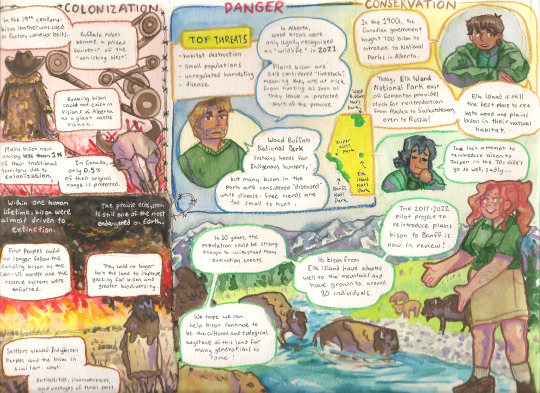
Parks Pass: What are Bison?
I've been working on this for well over a month, although I've been thinking about it since I received this ask last fall. Bison are so central and important in prairie history, ecology, spirituality, etc. and I feel that they exemplify this more than perhaps any other living thing here... I don't think I will go this in depth into other wildlife for this series.
I am not a naturalist nor do I represent Parks Canada or related organizations, all of this information has been sourced through reports from Parks Canada, organizations like CPAWS, etc. There are a lot of questions surrounding ecology, legalities, and reconciliation with Indigenous peoples that I just am not equipped to answer by myself... but I wanted to give as clear an overview as I could of the challenges and successes around bison in Alberta.
More notes, close ups, etc. below. I will try to link to some sources in the notes as a reblog.
I tried my best to make each panel stand mostly on its own so that you could read them in any order, but I hope there is a bit of a flow to the information... The pieces were slightly bigger than my scanner, so I apologize for some blurry writing and cropped edges!


(yak left, bison centre, buffalo right) (You will find all three domestic in Alberta, at least at agricultural fairs if not commercially)
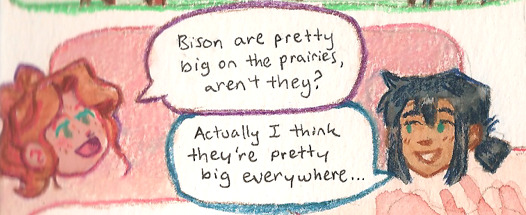
[ badum tishhhhhhh]

I tried to get the moose and our guides to scale physically, but it was tricky! Also: the summer ochre cape tends to appear on male plains bison.
There is debate as to whether wood and plains bison should be classified as separate species at all. The fact is, there remains a legal distinction in Alberta that will become relevant in a few panels.

This safety tip is if you're on foot- in a car, obviously stay in your vehicle! Don't attempt to drive through bison either, just let them pass!
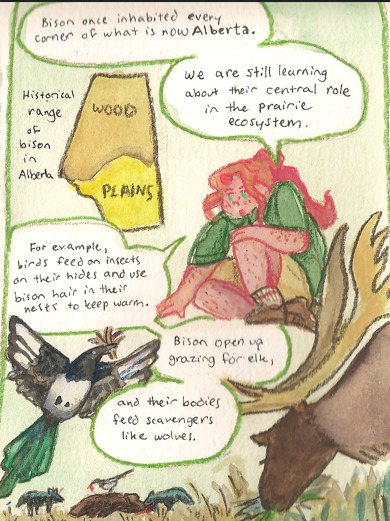
The "Ecology" title got cut here, my apologies.
Some other ways bison improve the ecosystem is by literally rolling around and trampling on the landscape, the churning of the land and the fertilization from buffalo dung helps plants and insects thrive, which in turn benefits all creatures along the food chain. Cows do not nearly replace the magnitude to which bison benefit the prairie.

Often in school, the sole fact one might learn about the First Nations of the plains involves a diagram of all the uses of each part of a bison. These descriptions have almost always been in the past tense, in order to place Indigenous peoples and their ways of life purely in the past. This is not a reflection of reality- many Indigenous folks in Alberta are still maintaining their traditions and their relationships with bison today. The tee pee here is based off of a Blackfoot design featured at the Royal Alberta Museum. Also pictured is a drying rack of meat, and a bison stomach suspended as a cooking pot. Pemmican is often described these days as a "superfood" or the ultimate protein bar; it is a mixture of dried meat and berries that both preserves well and is extremely nourishing.
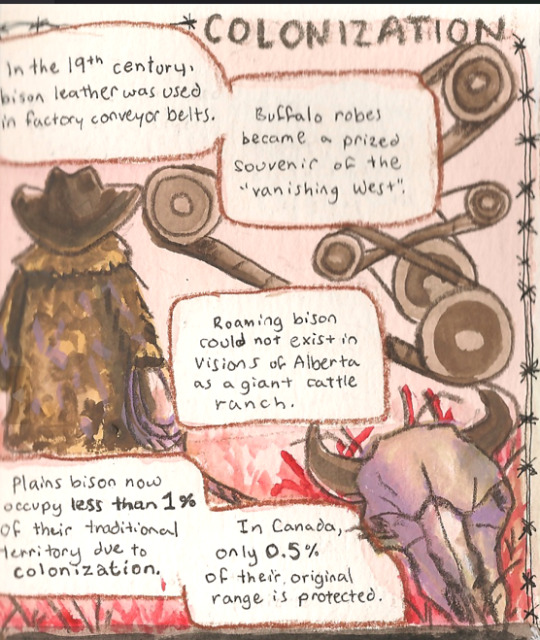
It is difficult to summarize the impacts of colonization in a short space, especially where bison are concerned. The creation of Treaty 7 in Alberta, particularly, was a result of an intentional and devastating eradication of the bison by settlers. This forced First Nations such as the Blackfoot Confederacy into impossible positions: follow the buffalo into the United States and risk attack from the Americans or the Sioux as the herds became smaller and smaller, or to agree to the Canadian government's terms to stay on a fraction of their traditional territories in order to keep from starving to death.
At the same time, anthropologists, collectors, and tourists tried to buy or take anything they could get their hands on from what they perceived as the end of an era: salvage anthropology of First Nations in the West painted an image of "pure" native culture that was about to be lost forever, while First Nations peoples were being forcibly assimilated, excluded, or eradicated by settlers.

There is still a lack of understanding in mainstream settler Canadian culture of the human labour that went into the creation of the "natural" "wilderness" of this land. This is something that the settlement, the industrialization, and the creation of national parks in Alberta and elsewhere ignores or erases, but there is a growing awareness and acknowledgement of the relationship between First Peoples and the land.
The prairie ecosystem remains extremely endangered and little understood, especially as environmental activism tends to focus on deforestation or pollution of the ocean rather than the destruction of native grasses and shrubs.
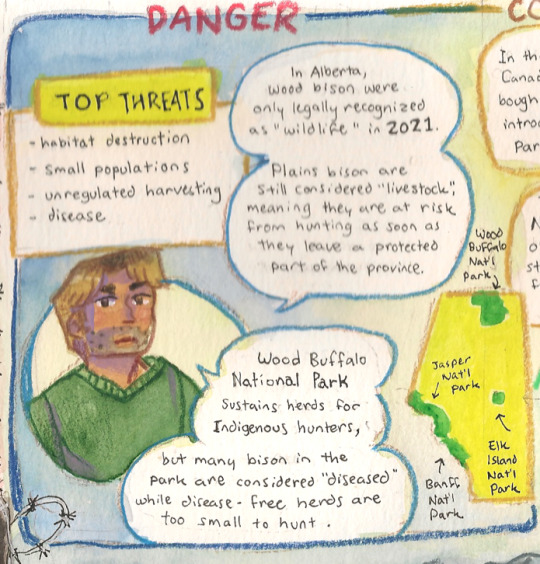
Cameo ft. Mac representing Wood Buffalo National Park, which spans the border of the Northwest Territories and Alberta. Obviously, the main cause of environmental destruction surrounding the park involves human industrial activity: logging, mining, and development of the oil patch. Disease can be easily transmitted between bison and cattle and can easily wipe out already struggling populations.
I was shocked to discover that all bison were considered livestock as recently as two years ago and could thus be harvested by anyone, anytime, and anywhere outside a protected area. Plains bison still do not have status as "wildlife".
The province did recently expand the "buffer zone" outside of Banff National Park, giving the Park a chance to recover bison that have wandered outside of the barriers before they become 'fair game', as it were.
Also worth noting: B.C. and Saskatchewan both protect bison under their provincial wildlife acts, but plains bison leaving those provinces and entering Alberta or Manitoba would be considered livestock as they are unprotected.

Elk Island stocks bison across the continent and around the world, which is incredible! Not all of those original 700 were sent to Elk Island, unfortunately those sent to what was once Buffalo National Park did not make it.
Likewise, a project to reintroduce bison to Jasper didn't bear fruit. An article via Jasper Local I had found earlier (that no longer seems to work) describes the discovery of a bison skull at Talbot Lake that most likely represents a bison from this recent reintroduction attempt.

The Banff bison reintroduction pilot (2017-2022) is the most recent attempt to reintroduce bison to areas of Alberta, and so far from the initial Spring 2023 report one of the more successful projects. Public sentiment both locally and internationally is very positive, with a lot of attention on social media, articles, and other outreach methods. The project is also partnering closely with all the First Nations in Treaty 7, as well as other community stakeholders such as visitors to the park, local residents, nearby ranchers, etc.
Phew, I just threw a ton of info at you! I hope this answers the question :)
#projectcanada cities#pc: banff#pc: jasper#pc: fort mcmurray#pc: edmonton#eleanor crandell#jasper swift#reginald buffalo#edward murphy#traditional art#ink#pencil crayon#watercolour#gouache#mixed media#boab ask#boab park pass
35 notes
·
View notes
Text
cow dung online shopping
Discover the natural power of cow dung products at our online store. Shop a wide range of organic fertilizers, home decor, and skincare items made from high-quality cow dung. Harness the eco-friendly benefits and nourishing properties of cow dung for a sustainable lifestyle. Browse now.
https://daasoham.com/
2 notes
·
View notes
Text

Many Indians have a special place in their hearts for cows, which are treasured in the Hindu religion. They are venerated as representations of riches, strength, and motherly love and are thought to have heavenly and healing properties.
One of the reasons for cow sacred in India is that they are considered a symbol of the divine mother, or "Gau Mata." In Hinduism, the cow is seen as a representation of all that is holy and pure and is believed to be able to nourish and sustain life. The cow is also seen as a symbol of selfless giving, as they provide milk, cow dung, and other resources to humans without expecting anything in return. Humans use these raw materials from cow and prepare milk-based products, dairy products etc.
The other reason why cows are worshiped in India is that they are believed to have medicinal properties. Cow's milk, urine, and dung are all used in Ayurvedic medicine to treat a variety of elements, and many people believe that consuming these products can bring good health and blessings.
In India, cows are revered not only for their spiritual importance but also for their usefulness in everyday life. Cow waste, which can be used in a variety of ways to benefit the environment and the economy, is one of the most precious resources that cows offer.
Using cow waste as fuel is one of the most popular uses for it. Biogas is made by the use of cow dung. It is a clean and renewable. Cow dung is nutrient-rich and can be utilized to increase the fertility of the soil. It works well in place of artificial fertilizer because it is a natural pest. In Hinduism, cow urine which is highly revered is thought to have medicinal powers. It is used in Ayurvedic medicine to treat a number of illnesses, including fever, skin conditions, cancer etc. Additionally, it is an antibacterial and a component of pesticides and cosmetics.
Cow waste is a useful resource that can be applied in a number of ways to help the economy and the environment. Cow waste has a wide range of useful applications that are worth exploring, from biogas production and crop fertilization to the treatment of diseases and being a sustainable building material.
We at Gogarbha understand how important and gainful the cows are. We've taken it upon ourselves to spread awareness and appreciation of these organic products with our company. With Gogarbha, you can feel safe knowing that you're supporting a sustainable source of nutrition while aiding in environmental protection - it's something we all need more of in this age!
We offer you the best-handpicked products blended with natural herbs that are not just the finest but also fine-tuned to meet your needs in home care.
At our company, we are proud to offer a range of desi cow products for your home care needs, such as:
Diya
Cowdung Sambrani Cones
Cowdung Sambrani Cups
Cowdung Dhoop Cakes
Cowdung Cakes
Mosquito Repellent
Vanaraksha Amrutham
Phenoyl
Our desi cow products have spiritual value in addition to being healthy for the environment. In Hinduism, cow manure is revered and thought to have both holy and therapeutic properties. We are dedicated to creating eco-friendly and sustainable products, and we anticipate that our cow waste line will have a positive effect on both the environment and the communities in which it is used.
In conclusion, cows are venerated in India as a symbol of the divine mother, selfless service, therapeutic benefits, wealth and success, and nonviolence. The Hindu community reveres and defends them, and they are important to the nation's religious and cultural customs.
Let us know in comment section which are the desi cow products that you use regularly.
6 notes
·
View notes
Text
Cow Welfare: UP Government's Scheme for Goshalas Development
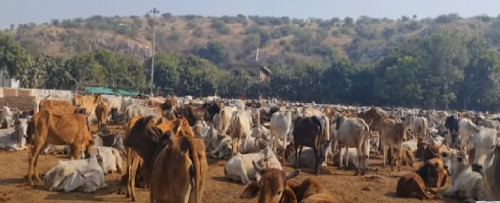
Greetings Goshalas are important in India. Goshalas, also known as cow shelters, are an important part of rural Indian culture. They support the sustainability of agriculture while giving cows, especially stray and non-productive ones, a safe refuge.
The emphasis of the UP government on cow welfare The Uttar Pradesh government launched a special program for the development of goshalas as part of its proactive efforts to advance cow care. In addition to promoting rural livelihoods, this effort seeks to protect cow welfare.
The Scheme's Overview Goals of the Plan The plan aims to:
Ensure that stray and unproductive cows receive the required care and housing. To strengthen the rural economy, promote items made from cows. Make careful you use organic fertilizers to ensure sustainable farming methods. Allotment of Budget Significant funding has been allotted by the UP government for this program, guaranteeing adequate cash for goshala operating needs, healthcare, and infrastructure development.
The Initiative's Principal Elements construction of contemporary cow shelters. frequent veterinarian treatment and vaccinations. encouragement of the production of cow-based goods, including organic fertilizers. The Scheme's Advantages Better Care and Health for Cows The program makes sure cows are healthier and live longer by providing them with adequate housing, consistent nutrition, and medical attention.
Strengthening of the Rural Economy The program encourages the development of cow-based goods, such as methane and fertilizers, giving rural communities new sources of revenue.
Ecological Resource Utilization The use of cow pee and dung to make organic insect repellents and fertilizers lessens reliance on chemical substitutes.
Important Elements of the Plan: Infrastructure Development, Shelter Construction, and Upkeep Building well-equipped shelters that shield cows from harsh weather and offer plenty of room for grazing is a key component of the plan.
Feeding Facilities A consistent supply of wholesome cow feed, such as green fodder and supplements high in minerals, is given special consideration.
Medical Attention for Cattle Vaccination Campaigns To improve the general health of cattle and avoid illnesses, regular vaccination campaigns are planned.
Veterinary Care Services To offer routine health examinations and on-site medical support, mobile veterinarian units are sent out.
Product Development Based on Cows Fertilizers Made of Organic Materials In addition to helping farmers, the program stimulates the creation of organic compost from cow manure, which supports environmentally sustainable methods.
Urine-Based Products and Cow Dung The development of goods like bug repellents, floor cleaners, and biogas gives the goshalas access to new sources of income.
Effect on the Creation of Employment in Rural Communities In Goshalas, the program generates employment for caregivers, veterinarians, and people who process items made from cows.
Boosting of Regional Ecosystems Soil fertility and biodiversity are restored by the project, which encourages organic farming and lessens reliance on chemicals.
Implementation Challenges: Limited Resources in Remote Areas A lack of competent workers and insufficient financing are two issues that certain rural regions confront, which hinders the scheme's efficient implementation.
Issues with Monitoring and Transparency Effective scheme implementation still faces major challenges in maintaining openness and consistent oversight of finances and operations.
How to Effectively Implement It Community Participation Accountability and improved resource use are ensured when local communities are involved in goshala management.
Utilizing Technology to Keep an Eye on Digital technologies may monitor the development of cow-based goods, healthcare services, and the distribution of funds.
Staff members at Goshala receive regular training that enhances their abilities in resource management, product creation, and cow care.
In conclusion, It is admirable that the UP Government is fostering sustainable rural livelihoods and enhancing cow welfare through the Goshala Development Scheme. While maintaining the traditional value of cows in India, this program has the potential to revolutionize rural economies by concentrating on infrastructure, healthcare, and cow-based industries.
0 notes
Text
Biogas in Kerala: Myths, Facts, and the Way Forward

Biogas technology has revolutionized waste management and renewable energy solutions, especially in eco-conscious regions like Kerala. Despite its growing adoption, various myths surround biogas, often deterring people from reaping its benefits. Let’s explore some of these myths, debunk the misconceptions, and understand the significance of biogas in Kerala.
What is Biogas?
Biogas is a clean and renewable energy source produced through the anaerobic digestion of organic waste like kitchen scraps, animal manure, and agricultural residues. It provides a sustainable way to manage waste and generate energy simultaneously.
In Kerala, where waste management is a pressing concern, biogas plants have emerged as an ideal solution for both urban and rural communities.
Common Myths About Biogas and the Facts
Myth 1: Biogas Plants Are Difficult to Maintain
Fact: Modern biogas plants are designed for user-friendliness. Proper training and routine maintenance, such as feeding the digester with the right mix of organic waste, can keep the plant running efficiently. In Kerala, government and private agencies provide training and support for biogas users.
Myth 2: Biogas in Kerala Cannot Handle All Types of Waste
Fact: Biogas plants are highly adaptable and can process various organic materials, including food scraps, cow dung, and even agricultural waste. Kerala’s agricultural background makes it easy to source suitable feedstock for biogas production.
Myth 3: Biogas Plants Need Large Areas
Fact: Kerala’s high population density might seem like a challenge for biogas adoption, but compact and portable biogas plants are available for homes and small businesses. They fit into urban backyards or even rooftops, making them viable for cities like Kochi and Thiruvananthapuram.
Myth 4: Biogas is Inefficient for Energy Production
Fact: Biogas systems in Kerala are tailored for high efficiency. Advanced technology ensures that waste-to-energy conversion is optimal, providing sufficient gas for daily cooking and heating needs in homes and businesses.
The Role of Biogas in Kerala’s Sustainability Journey
Kerala is a state known for its progressive environmental policies and green initiatives. Biogas technology aligns perfectly with Kerala’s goals for:
Waste Management: Biogas plants address the challenge of managing organic waste by converting it into usable energy and organic fertilizers, reducing the dependency on landfills.
Renewable Energy: With the rising cost of LPG and electricity, biogas provides an affordable and renewable alternative for households and small businesses in Kerala.
Agricultural Support: The by-product of biogas plants, known as slurry, is a nutrient-rich fertilizer. It enhances soil fertility and supports Kerala’s agricultural practices.
Biogas in Kerala: A Green Revolution in Action
The government of Kerala, along with NGOs and private organizations, actively promotes biogas adoption through subsidies and awareness campaigns. Many households, schools, and even hotels in Kerala have embraced biogas as a sustainable solution for waste management and energy production.
Conclusion
Biogas in Kerala is more than just a technology — it’s a movement toward sustainability. By debunking myths and spreading awareness, we can ensure greater adoption of biogas systems, contributing to a cleaner and greener state.
#biogas in kerala#biogas plant for home#incinerator manufacturers in kerala#portable biogas plant for home#incinerators in kerala#biogas#kerala
0 notes
Link
1 note
·
View note
Text
All Information of Biogas Plant
All Information of Biogas Plant
Regarding biogas plant
Mainly animal dung, pig-chicken faeces, animal urine, human faeces if toilet is attached, kitchen waste, wasted vegetable shreds etc. can be used for biogas plant. However, if wet grass, green leaves are used immediately in the biogas plant,
there is a risk of increasing acidity in the gas plant, so these materials should be decomposed well for five days and then left in the plant. If the beneficiary has Janata type biogas, the inlet (supplementary trap) of the said plant is larger. In a biogas plant, cow dung or other decomposable materials are mixed with water in their specific proportions to start their natural decomposition process. This process takes place in the absence of air. Decomposition is facilitated by vacuum bacteria. The gas produced is stored in the upper dome. This gas contains 50 to 75 percent methane gas, 25 to 50 percent carbon dioxide and up to one percent hydrogen sulphide.
The slurry formed after the decomposition of the materials in the biogas plant is released due to gas pressure. Slurry is a high quality organic fertilizer. Since the decomposition process in a biogas plant takes place in an airless manner, there is no problem in using human excreta or other animal excrement. If a toilet is attached to the biogas plant, do not use phenyl, detergent soap to clean it. This can kill airborne germs, as well as stop the decomposition process.
Biogas Slurry Fertilizer
Fertilizer from biogas can be used in two ways, liquid and solid (dried). This fertilizer helps in increasing the fertility of the soil. If the manure is used in the field in the form of slurry, the manure is useful for the crop in the field.
If the distance between the Gobar gas and the beneficiary's farm is long or if transportation is difficult, it will be difficult to transport the liquid manure to the farm. In that case, a pit will have to be prepared near the gas plant to store manure. Two pits have to be made adjacent to the outlet for storing manure. After filling one pit, slurry should be left in the other pit. After drying, the manure should be used in the field according to the season.
Space for biogas
To make biogas, choose a high, dry, open place near the house and get sunlight for a long time. The place should preferably be near a house or cowshed. The water level under the ground should be below two meters. There should be no trees, water well, water hand pump near the selected place. After getting approval for biogas construction, the size of the biogas plant should be decided and constructed according to the capacity, taking into account the number of animals and people in the family.
Types of biogas
Only the biogas model approved by the central government should be constructed. By construction, there are two types of biogas: floating gas tank plant and fixed dome plant. Its construction should be planned taking into account the type of local land and climate. Fixed dome type of plant should be constructed in the areas where there is moorum and Tambus soil type. Where there is black soil or soil swelling due to water, ferrocement, pre-fabricated ferrocement type of biogas should be constructed.
Fixed dome plant type biogas is a low cost biogas. It is affordable to the common beneficiary, but the construction of this plant has to be done by trained and skilled masons. Construction of floating tank biogas is costly.
Subsidy for biogas
Biogas construction in rural areas is subsidized through the Ministry of New and Renewable Energy of the Central Government. If the beneficiary does not have financial capacity for biogas construction, loans are provided from nationalized and cooperative banks. The subsidy amount received is credited to the loan account of the beneficiary. In addition, if biogas is used for purposes other than cooking (e.g. - saving diesel by reducing the use of other energy sources, using biogas for generators, refrigerators) a subsidy of Rs.5000 per plant is given. Depending on the type of biogas you want to build, you have to consider its cost. Some NGOs are involved in the implementation of the National Biogas Development Scheme. Agriculture Department for updated information on biogas scheme.
Biogas process
A device designed to store the gas produced after the decomposition of organic matter in an anaerobic state by bacteria is called a biogas plant. It produces methane and carbon dioxide. Methane is a gas that aids in combustion. Producer gas from biomass gasifier is used for pumping water, generating electricity, and also for cooking. Biomass gasifier plants are available in various capacities and can be used as per requirement.
Biogas gas consists of methane 55 to 70 percent, carbon dioxide 30 to 40 percent with small amounts of nitrogen and hydrogen sulphide. Methane is a flammable gas. Biogas is produced from any type of waste material that decomposes. E.g. Dung, household scraps, waste vegetables, animal dung, human excreta, etc. The material is mixed with water and released into the digester in the inlet chamber of the biogas plant. Over time, efficient bacteria are formed in the digestive system and acetic acid is produced
0 notes
Text
Welcome to Pasuthai
When Britishers invaded India, they were astonished for two things:
one is our Gurukul Education & the other one is our traditional method of Farming / Agriculture. We worship Cow next to our Mother & Motherland.
Preserving India’s Agricultural Heritage: The Significance of Bharatiya Cows in Traditional Farming.
India’s rich agricultural heritage has been shaped by centuries of traditional farming practices, rooted in sustainability, harmony with nature, and great respect for the land. Central to this agricultural ethos is the integral role played by Bharathiya cows, which are greatly respected not only as sacred animals but also as essential\important partners in farming. However, during the colonial era, British rulers sought to undermine these traditional practices, recognizing the potential threat they caused to their economic interests. This article explains the profound significance of Bharathiya cows in traditional Indian farming and the deliberate efforts by colonial powers to disrupt this harmonious system.
The Role of Bharatiya Cows in Traditional Farming:
In traditional Indian agriculture, Bharathiya cows are considered sacred and are deeply integrated into farming practices. These indigenous cow breeds, such as Gir, Sahiwal, and Tharparkar, provide more than just milk; they are valued for their dung and urine, which serve as invaluable resources for fertilization and pest control.
Cow Dung as excellent Fertilizer: Bharathiya cow dung is renowned for its high nutrient content, making it an excellent natural fertilizer. When mixed with other organic matter, such as crop residues and compost, cow dung enriches the soil with essential nutrients like nitrogen, phosphorus, and potassium, promoting soil fertility and enhancing crop yields.
Urine as Pesticide: Cow urine, also known as “Gomutra,” has long been revered in Ayurveda for its medicinal properties and pest-repellent qualities. When diluted and sprayed on crops, cow urine acts as a natural pesticide, warding off pests and diseases while promoting plant health. Its antibacterial and antifungal properties make it an effective alternative to chemical pesticides, without harmful environmental impacts.
The Colonial Agenda to Undermine Traditional Farming:
During British colonial rule in India, the agricultural landscape underwent significant transformations driven by imperialist agendas aimed at exploiting India’s resources for the benefit of the colonial power. Recognizing the central role of Bharathiya cows in traditional farming, colonial administrators devised strategies to undermine these practices and promote dependency on British-controlled agricultural inputs.
Threat to Traditional Farming: Colonial administrators, including figures like Robert Clive, recognized the threat posed by Bharathiya cows to their economic interests. By promoting the slaughter of indigenous cow breeds and discouraging traditional farming practices reliant on cow dung and urine, they sought to dismantle the self-sufficient agricultural systems that had sustained Indian communities for generations.
Imposition of Chemical Inputs: Under colonial rule, the promotion of chemical fertilizers, manure, and pesticides became a central aspect of agricultural policies. British authorities motivated the adoption of imported chemical inputs, which not only displaced traditional organic farming practices but also created dependency on foreign markets, perpetuating economic exploitation and environmental degradation.
Preserving India’s Agricultural Heritage:
Despite the challenges posed by colonial interventions and subsequent modernization efforts, the importance of Bharathiya cows in traditional farming cannot be overstated. Today, as India confronts pressing environmental and agricultural sustainability challenges, there is a renewed interest in reviving indigenous farming practices and promoting the conservation of native cattle breeds.
Revival of Organic Farming: With growing concerns about chemical inputs’ adverse effects on soil health, water quality, and human health, there is a reappearance of interest in natural farming methods rooted in traditional knowledge. By harnessing the natural fertility of cow dung and urine, farmers can cultivate crops sustainably while preserving soil biodiversity and reducing environmental pollution.
Conservation of Indigenous Cattle Breeds: Efforts to conserve and promote indigenous cattle breeds like Gir, Sahiwal, and Tharparkar are gaining momentum across India. Government initiatives, grassroots organizations, and community-led conservation efforts aim to safeguard these invaluable genetic resources, recognizing their role in preserving biodiversity, enhancing rural livelihoods, and promoting sustainable agriculture.
Conclusion:
The enduring legacy of Bharathiya cows in Indian agriculture underscores the importance of preserving traditional farming practices rooted in ecological harmony and cultural reverence. Despite centuries of colonial exploitation and modernization pressures, the resilience of India’s agricultural heritage endures, offering valuable lessons for sustainable development and food sovereignty in the twenty-first century. By embracing indigenous knowledge and prioritizing the conservation of native cattle breeds, India can chart a path towards agricultural resilience, ecological stewardship, and cultural renewal.
Through a concerted effort to reclaim and celebrate its agricultural heritage, India can not only strengthen its rural communities but also inspire a global movement towards regenerative farming practices that nourish both people and planet.
In India Farm Animals particularly cattle are the backbone for Agriculture. We used Bharathiya cow’s dung as an excellent Fertilizer/ Manure & cow’s urine as a premium pesticide. Robert Clive thought, if cows are eliminated then Indian Traditional Farming method will be destroyed; if Bharathiya cows are slaughtered then Indian Farming will head to the path of devastation & thereby Indians are forced to depend on Britishers for Chemical Manure & Pesticides. Foreign Chemical Fertilizers, Manure & pesticides has made a way into India in this planned manner by Britishers.
0 notes
Text
Shri Venkateshwara University celebrated World Food day by hosting a seminar focused on promoting organic farming techniques.
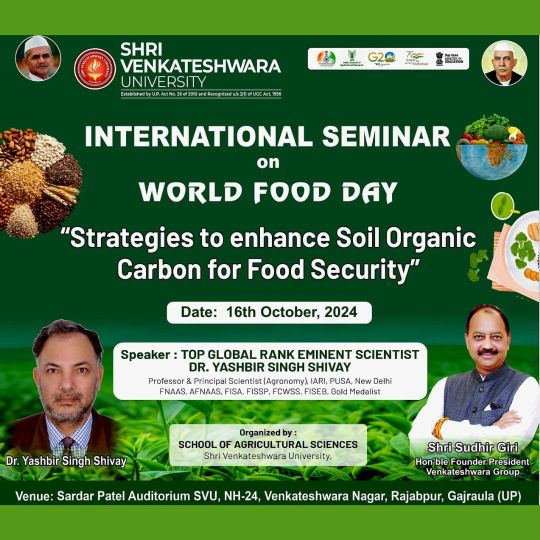
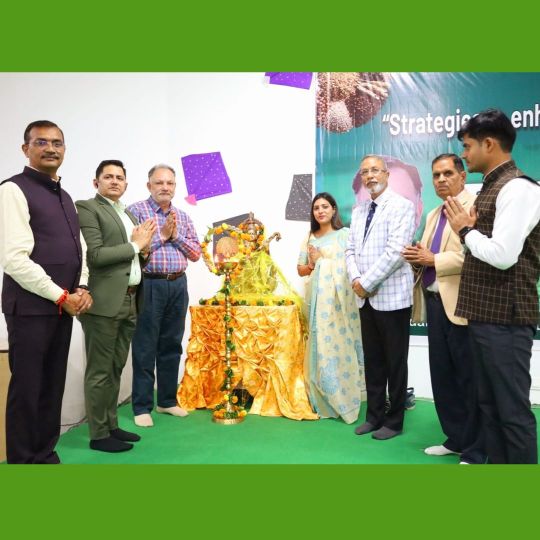
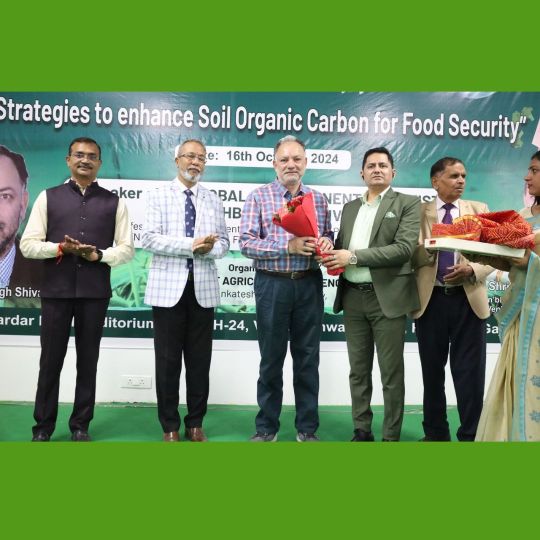
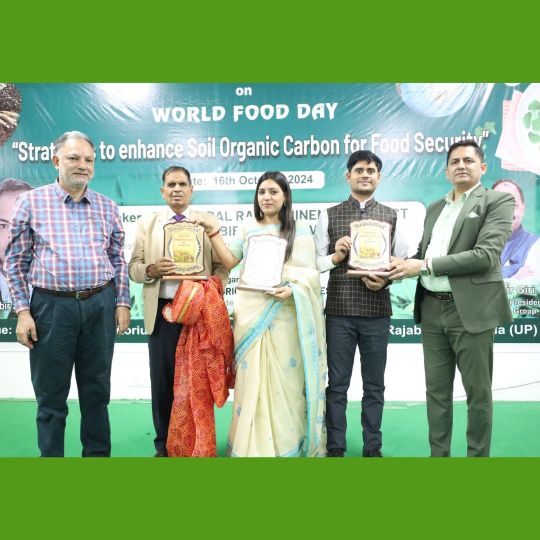
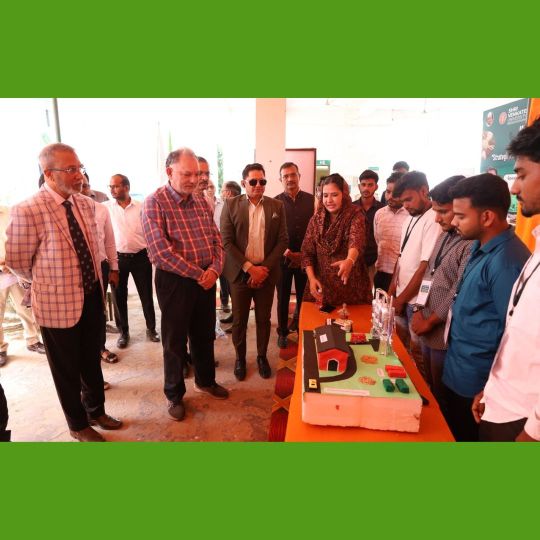
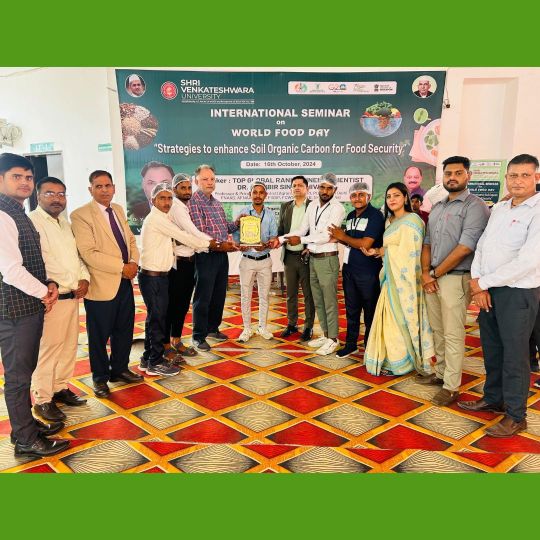


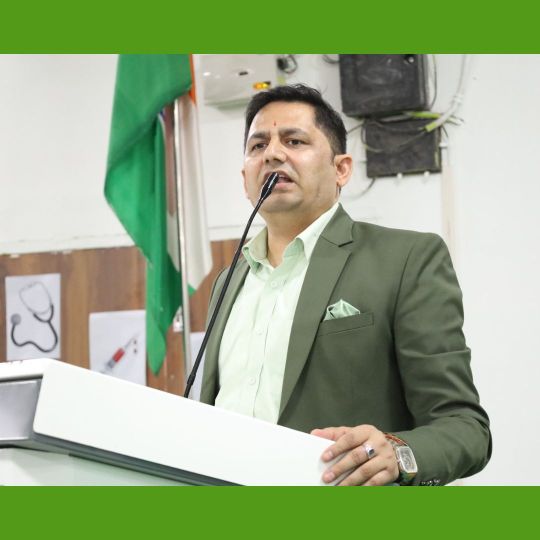
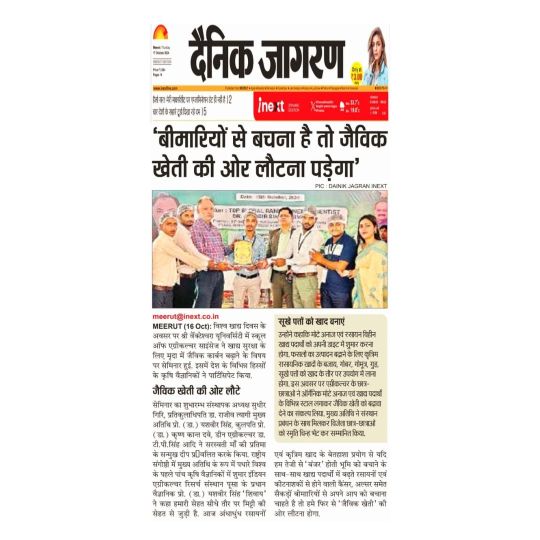
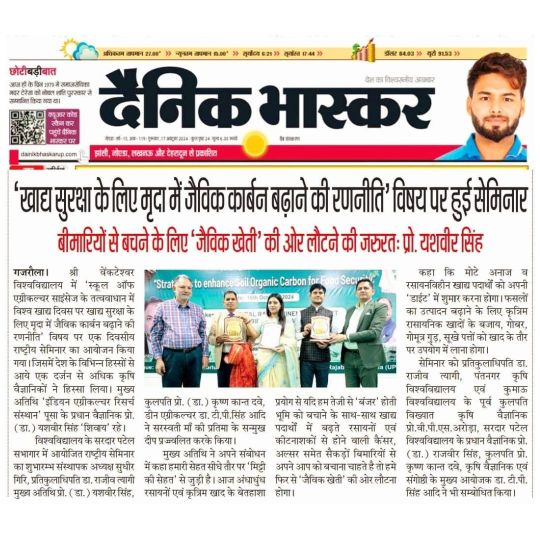







On the occasion of World Food day, Shri Venkateshwara University/Institute organized a seminar on the topic ‘Strategies to enhance soil organic carbon for food security ‘
The School of Agriculture Sciences hosted the 1 day national seminar that saw the participation of over a dozen agriculture scientists from all over the country.
Dr Yashbir Singh Shivay, Principal Scientist IARI Pusa & among the top 5 agriculture scientists in the world, was the Chief Guest at the event.
The Venkateshwara Group Founder President Dr Sudhir Giri, Pro Chancellor Dr Rajeev Tyagi, & the CG Dr Yashbir Singh inaugurated the event by lighting a lamp to Goddess Saraswati.
The VC Dr Krishna Kant Dave & the Agriculture Dean Dr TP Singh joined them to unveil the seminar on strategies to enhance soil organic carbon for food security.
The Agriculture students vowed to promote organic farming by showcasing various stalls about organic millets & food items.
The CG, along with the management, felicitated the winners by presenting them a memento for their excellent models promoting organic farming techniques.
The Venkateshwara Group Founder President Dr Sudhir Giri reiterated we can realize the dream of a Healthy India- Prosperous India through organic farming & green revolution only.
The Chief Guest, Dr Yashbir Singh Shivay, asserted our health primarily depends on the health of the soil.
Soil fertility is declining because of the unregulated use of chemical fertilizers. This poses health risks like cancer, ulcers, and other diseases caused by continuous chemical and fertilizer use in food.
To address this, a transition back to organic farming is needed to preserve soil fertility and protect our health.
We should include millets and chemical free food ingredients in our diet. To increase the yield of crops, we should replace chemical fertilizers with organic manure prepared from cow dung, urine, jaggery & dried leaves.
Dr Rajeev Tyagi, the Pro Chancellor, highlighted that farmers in UP west can avail free soil testing at Venkateshwara starting from February through the newly established Soil Testing Lab.
The seminar was addressed by several distinguished individuals. These included the Pro Chancellor, Dr. Rajeev Tyagi, former VC of Pantnagar Agriculture University and Kumaun University, Dr. VPS Arora.
Also speaking at the seminar were Principal Scientist of SPU, Dr. Yashveer Singh, VC, Dr. Krishna Kant Dave, and the Chief Organizer, Dr. TP Singh.
Those present included the Registrar Dr Piyush Pandey, Dean Agriculture Dr TP Singh, Dr CP Singh, Dr Abhishek Singh, Dr Mata Prasad, Dr Laxmikant, Dr Jyoti Singh, & Dr Vinay K Singh.
Dr Sheshnath Mishra, Dr Varun Tripathi, Dr Aashiya Wahid, Dr Chandrakant, Dr Kaushal Kumar, & Udit Tiwari were all present.
The Meerut Campus Director, Dr Pratap Singh, was present along with the Media Incharge, Mr. Vishwas Rana, among others.
Dr Jyoti Singh compered the program extremely well.
0 notes
Text
Green Gold fertilizer finds usage in gardening and agriculture. It is an organic, pure, and solid fertilizer consisting of cow dung slurry obtained from a biogas plant. This fertilizer uses a unique dual composting method, which involves two steps- anaerobic and aerobic digestion, resulting in full decomposition.
0 notes
Text

The Story Behind Venkateswara Gosamrakshana Trust
India's rich cultural and spiritual heritage is deeply intertwined with the reverence of cows, which have held a sacred position in Hinduism for millennia. Protecting and nurturing these divine creatures is seen not only as a religious duty but also as a way to promote harmony with nature and support sustainable living. The Venkateswara Gosamrakshana Trust was established with this very mission in mind—to safeguard and preserve India’s indigenous cow breeds while promoting ethical and sustainable practices that benefit the environment, agriculture, and rural livelihoods.
The Genesis of the Trust
The Venkateswara Gosamrakshana Trust was founded in the temple town of Tirupati, a place revered for its spiritual significance and home to the famous Tirumala Venkateswara Temple. This sacred connection has shaped the core philosophy of the trust, which views cow protection as an act of devotion to Lord Venkateswara.
The trust’s journey began as a response to the alarming decline in the population of India’s native cow breeds, driven by the rise of industrial farming and exotic, high-yielding cattle. Recognizing the ecological and cultural importance of indigenous cows, a group of passionate devotees, environmentalists, and community leaders came together to form the trust. Their aim was clear: to protect the native breeds, promote sustainable agricultural practices, and uplift rural communities dependent on cattle for their livelihoods.
The Mission and Vision
At its core, the mission of the Venkateswara Gosamrakshana Trust is “Gau Seva”—service to cows. This encompasses not only the physical care of cows but also the spiritual and cultural preservation of India’s relationship with these gentle animals. The trust strives to protect and nurture indigenous breeds that have been historically adapted to Indian climates, ensuring that they continue to thrive in a rapidly changing world.
The trust's vision extends beyond just the protection of cows. It aims to foster a symbiotic relationship between cows, humans, and the environment. Through this, the trust envisions a future where traditional farming practices are rejuvenated, rural communities are empowered, and ecological balance is restored.
Key Initiatives of Venkateswara Gosamrakshana Trust
1. Goshalas for Indigenous Breeds
One of the primary functions of the trust is to maintain Goshalas (cow shelters) where native cow breeds are housed, cared for, and nurtured. These shelters are more than just places of refuge; they serve as centers for education and research on how to improve the breeding, health, and management of these cows. The trust currently shelters thousands of cows across several facilities, ensuring that even unproductive or aging cows receive lifelong care.
2. Conservation of Native Cow Breeds
India is home to more than 40 recognized native cow breeds, each uniquely adapted to local conditions. Unfortunately, many of these breeds are on the brink of extinction. The trust is committed to the conservation and revival of these endangered breeds, focusing on selective breeding programs that aim to preserve their genetic purity. Through partnerships with research institutions and veterinary experts, the trust has developed effective breeding practices that ensure the survival of these valuable breeds.
3. Organic Farming and Panchagavya Promotion
The trust actively promotes the use of cow-derived products in organic farming. Indigenous cow dung and urine are essential ingredients in Panchagavya, a traditional natural fertilizer used in organic farming. This holistic approach to farming is not only sustainable but also helps improve soil fertility, reduce dependency on chemical fertilizers, and restore ecological balance. The trust encourages farmers to adopt these practices, providing them with training and resources to switch to organic methods.
4. Empowering Rural Communities
A critical aspect of the trust’s work is its focus on rural development. By providing indigenous cows to farmers and training them in sustainable agriculture, the trust helps create livelihoods that are both ecologically and economically sustainable. Farmers are encouraged to engage in dairy farming, organic fertilizer production, and natural pest control methods, all of which are rooted in traditional practices. This empowerment creates a self-sustaining cycle of growth and support within rural communities, reducing poverty and promoting economic resilience.
5. Education and Awareness
Education is at the heart of the trust’s efforts. Through workshops, seminars, and outreach programs, the Venkateswara Gosamrakshana Trust spreads awareness about the importance of cow protection, organic farming, and environmental conservation. The trust works closely with schools, universities, and agricultural organizations to instill a sense of responsibility toward indigenous cows and their role in a sustainable future.
The Spiritual Significance of Cow Protection
For the Venkateswara Gosamrakshana Trust, cow protection is not just about environmental sustainability or agricultural productivity—it is a spiritual practice. Cows are revered as sacred beings in Hinduism, symbolizing non-violence, selflessness, and the nurturing aspect of nature. By protecting cows, devotees believe they are directly serving Lord Venkateswara and ensuring the prosperity of future generations.
The trust integrates this spiritual philosophy into its daily operations. Many of the goshalas have temples where regular prayers are offered to the cows, and festivals like Gopashtami are celebrated with devotion. The spiritual dimension of the trust’s work serves as a powerful motivator for both its members and the broader community to engage in cow protection.
Looking Toward the Future
As the Venkateswara Gosamrakshana Trust continues its work, it faces both opportunities and challenges. With growing awareness about the environmental and ethical issues surrounding industrial farming, there is renewed interest in the revival of indigenous breeds and traditional agricultural practices. However, the trust must also navigate the practical challenges of scaling up its initiatives, securing funding, and ensuring that its message reaches a wider audience.
The trust’s leadership is optimistic about the future. With a dedicated team of volunteers, supporters, and farmers, they are confident that their mission will not only preserve India’s native cow breeds but also foster a more sustainable, ethical, and harmonious relationship between humans and nature.
Conclusion
The story of the Venkateswara Gosamrakshana Trust is a testament to the power of faith, tradition, and community in driving meaningful change. By championing the cause of cow protection and sustainable agriculture, the trust is playing a crucial role in preserving India’s cultural heritage while addressing modern challenges like environmental degradation and rural poverty.
In a world that is increasingly disconnected from nature, the trust’s work serves as a reminder that sometimes, the answers to our most pressing problems lie in the wisdom of the past. Through its unwavering commitment to cow protection, the Venkateswara Gosamrakshana Trust is leading the way toward a more sustainable, compassionate, and balanced future.
#CowProtection#GauSeva#SustainableFarming#NativeCows#SaveIndianCows#Gosamrakshana#IndigenousBreeds#OrganicFarming#RuralEmpowerment#CowConservation#Panchagavya#VenkateswaraTrust#GoshalaCare#EthicalFarming#SpiritualAgriculture#EcoFriendlyFarming#CowWelfare#TempleTrust#TraditionalFarming#GauRaksha#GreenFarming#CulturalPreservation#CowBasedEconomy
0 notes